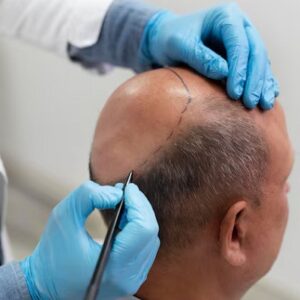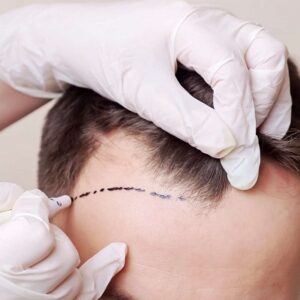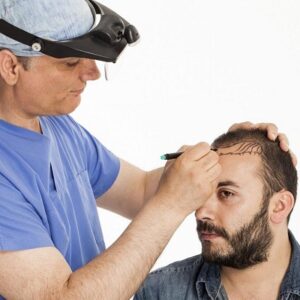
Do you feel sad or sick seeing holes near together? You may have trypophobia, the fear of microholes or bubbles. This phobia can cause discomfort or an irrational fear of holes or speckled patterns. Extreme stress or generalized anxiety disorder may develop.
Hair transplantation leaves circular holes on the scalp due to minute incisions, which may explain this concern. This page has all the information you need about this subject.
We will also talk about overcoming your fear of little hair holes and acquiring great results with hair transplant surgery.
What is trypophobia?
Trypophobia, which means “fear of holes,” is an anxiety disorder that causes severe fear and discomfort of objects with clusters of microscopic holes or bumps. Trypophobia is the fear of donor and recipient hair transplant holes, which form during surgery.
Hair transplant surgeons use micro-punch equipment for Follicular Unit Extraction (FUE). It retrieves hair follicles from the rear and side of the head.
Symptoms:
Trypophobia has many symptoms.
- Some people may feel uneasy when they see photos of the things, while others may have an anxiety attack.
- Feeling ill, sweating, breathing fast, and having a pounding heart are common symptoms.
- Some people may experience fear, dread, or panic.
What causes trypophobia?
Trypophobia can be caused by sponge, honeycomb, and lotus seed pods. Additional examples include bubble wrap and abstract shapes. Although the condition is new and has received little attention, it now appears to be a global issue.
The cause of trypophobia is unknown. Some studies suggest it’s linked to an evolutionary need to survive and a fear of hazardous animals. Trypophobia sufferers may sense panic because hole patterns resemble poisonous snakes or frogs.
How Can You Overcome Your Hair Transplant Fear?
Managing hair transplant trypophobia might be worrisome, but these therapies may help:
Applying Exposure Therapy:
Exposure treatment allows you to face your phobia in a safe, supportive environment. This therapy will change your response to trypophobia triggers. This step may minimize your anxiety, dread, or anguish when faced with crowded holes.
CBT is cognitive behavioral therapy:
CBT treats trypophobia by helping you manage your fear and anxiety. Cognitive behavioral therapy (CBT) helps you change the actions or thoughts that caused trypophobia.
The drug:
If trypophobia is linked to anxiety or depression, the doctor may prescribe medication. For instance, the doctor may prescribe anti-anxiety medication before the hair transplant to avoid triggers.
Meditation and breathing exercises:
Relaxing your mind and body with breathing exercises is simple and effective. Take deep breaths to calm and slow your heart rate. This can slow or stop triggers. Meditation has been demonstrated to reduce anxiety and relax tensions.
Why does trypophobia stigmatize hair transplants?
Hard to say! Trypophobia is likely linked to hair transplantation by clinics with a bad reputation and those that don’t use modern techniques.
Trypophobia is caused by larger hair transplant holes, which may be performed in uncertified clinics using outdated techniques. This may worsen hair transplantation’s image.
How should I handle discomfort from my hair transplant procedure?
If you are worried about hair transplant holes, we recommend looking at our before and after results. Even though your trypophobia may make you nervous in the short term, you should consider how your new hair will look after a year.
With no scabs and a thick, beautiful hairline, you’ll wonder why all the fuss is made. No scalp holes were produced during the hair transplant, as shown in this shot. After 10-14 days, the scabs will be gone, allowing you to begin hair restoration.
Hair transplant scars and trypophobia:
Any surgery will cause scarring, and hair transplants will leave donor site scars. The size and look of these scars depend on how the hair follicles are harvested during surgery.
Hair follicles can be extracted via FUE or FUT. Shaving the donor region and using a micropunch to remove hair follicles is follicular unit extraction (FUE) hair transplantation.
With this instrument, many small punch wounds are generated in the donor location. Each incision leaves a circular scar around the extracted follicle. These scars look like tiny red patches since their diameter is less than one millimeter.
How Long Do FUE Hair Transplant Holes Disappear?
FUE hair transplants leave small, circular scars in the donor site, which will fade as surrounding hair regrows. Small scars form on the donor location. This takes about a month.
To compare, recipient region holes will disappear in about a month. During this time, transplanted hair follicles will root. Scabs will form around incisions as they heal.
One month will remove the scabs, dried blood, and holes, but your new hair will not have grown. Your new hair won’t be grown yet. The plastic surgery will leave your scalp looking the same.
Consultation:
Trypophobia, caused by hair transplants, is disastrous. If you have trypophobia and want a hair transplant, talk to your doctor of Dynamic Clinic Pk. They can help you manage your anxiety and stress during treatment and recovery.












